|
Curtiss P-40M / N
Kittyhawk Mk.IV
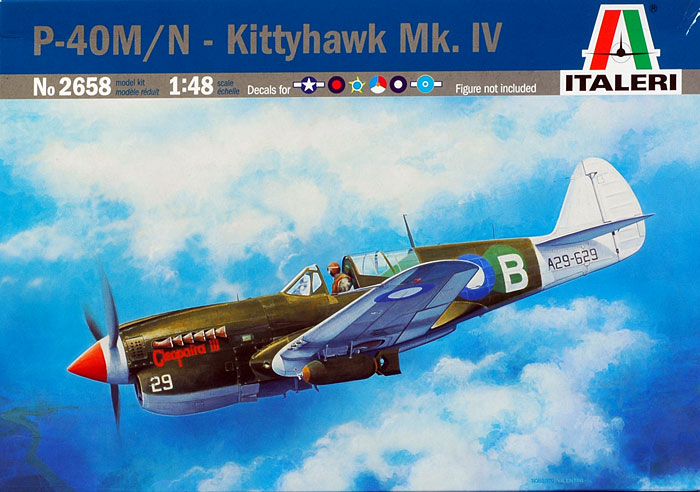
Italeri, 1/48 scale
S u m m a r y
|
|
Catalogue Number: |
Italeri No. 2658 -
Kittyhawk Mk.IV |
|
Scale: |
1/48 |
| Contents and
Media: |
around 65
parts in grey plastic; seven clear plastic parts; markings for
six aircraft. |
| Price: |
GBP£15.31
will be available online from Hannants website and
retailers worldwide |
| Review Type: |
FirstLook |
| Advantages: |
Most numerous variant
of this important fighter; accurate outline; reasonable level of detail; useful options
with all parts needed for either P-40M and N variants;
high
quality clear parts; excellent marking options. |
| Disadvantages: |
Some mould
deterioration evident on rear fuselage; small details
missing (see text); wheels not appropriate for P-40N |
|
Recommendation: |
Recommended |
Reviewed by Brett Green

Italeri's 1/48 scale P-40M/N will
be available online from Squadron.com
If this kit looks a little familiar, it is because the sprues have been
released in other guises.
The initial version of this kit was a P-40N and several other variants
from AMT in the early 1990s, followed by AMtech's release of P-40E, F, L
and K kits based on the same family of moulds between 2002 and 2005.
However, we have not seen the P-40N since the original AMT boxings of
the 1990s.
It should also be noted that, as far as I am aware, this is the first
time that all the parts required for both the M and the N variants have
been included in a single box.
Italeri's 1/48 scale P-40M/N comprises around 65 parts
in medium grey styrene and seven parts in clear. Panel lines are crisply
recessed, complimented by restrained lines of rivets here and there.
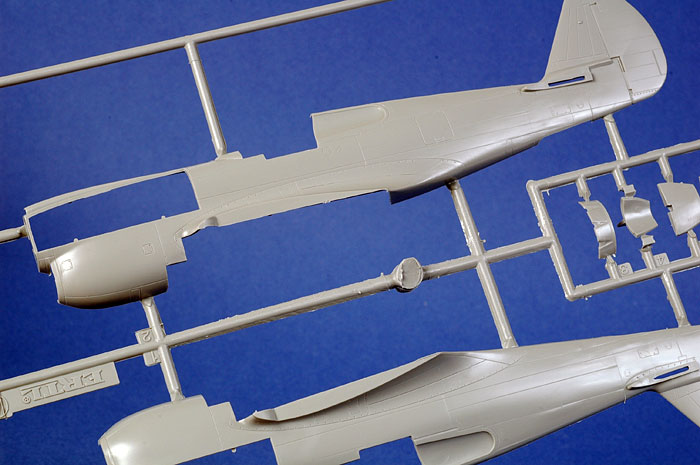
Click the thumbnails below to view larger
images:
[../../../photogallery/photo00025789/real.htm]
Detail in the cockpit is adequate. Wheel wells are boxed in on three
sides, but the main undercarriage legs are a little simplified.
Supplied stores include two 500lb bombs and a centreline
drop tank.
Some smaller details are missing. These include the ring and bead
gunsight, mirror, whip antennas, fuselage spine navigation light, fuel
dump, fresh air intakes and landing gear indicators. The canopy rails
have also been omitted. All of these items can fairly easily be added
from scrap plastic and other materials commonly found in the modelling
toolbox.
The wheels are the larger variety appropriate for variants up to the
P-40M. The P-40N used smaller diameter wheels. Fortunately, four
different varieties of accurate P-40N wheels are available in resin from
Ultracast.
The overall shape and contours are good, but the spinner comes to a
perfectly sharp point. The overall profile of the aircraft looks better
when this part is slightly rounded-off.
The moulds have held up quite well over the years, but there is some
slight distortion of the plastic on the rear fuselage. It is not
terrible, but some modellers may want to smooth and rescribe this area..
The clear parts are impressively thin and free of
distortion.
For the first time, this kit offers the clear parts for both the (P-40M
Kittyhawk III), and the P-40N (Kittyhawk IV)
The sliding section of the canopy will ride high when in the "open" position
on both variants.
A vacform replacement will address this problem.
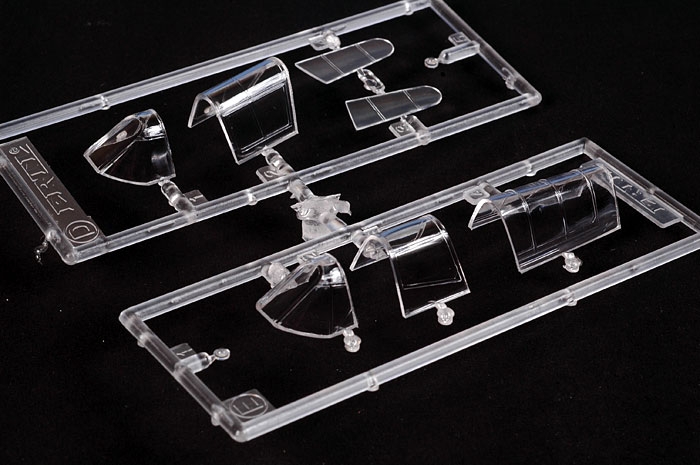
Kit engineering is quite conventional. I have built a few of the AMtech
versions of this kit and the only troublesome area is the fit of the
engine cowling panels. I recommend that these panels should be glued in
place before the fuselage halves are joined. Last time, I "tacked" the
panels in place with super glue, then made the bond permanent with
liquid glue. There may also be a gap at the wing root join. Check the
fit before gluing the wing to the fuselage and, if necessary, a spreader
bar can be installed to widen the fuselage.
If you are building the P-40N / Kittyhawk IV, you will need to cut out a
section of the fuselage spine immediately behind the cockpit. This is
well marked on the inside of the fuselage with a deep cutting line. Note
that the joins do not coincide with panel lines, so you should fill and
sand these to eliminate any unwanted seams.
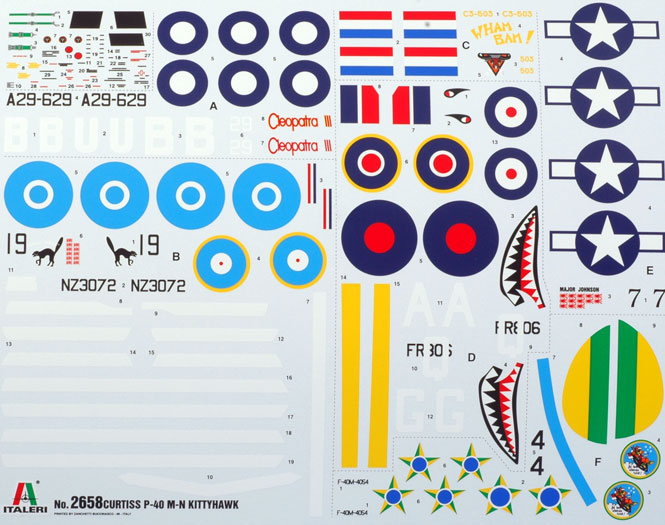
Six marking options are offered, including two US P-40s in bare metal,
Olive Drab examples from Australia, New Zealand and Brazil, plus Dutch
and British Kittyhawks.
There is no doubt that Hasegawa's new 1/48 scale P-40N kit offers
clearly superior detail and surface features compared to this kit.
Even so, I have a bit of a soft spot for these AMT-sourced P-40s.
They are easy to build (arguably easier than Hasegawa's), with
relatively few fit problems. If you are building the P-40M, the only
inserts are the cowl panels and these fall on natural panel lines.
Italeri's P-40M/N will also appeal to modellers on a budget, as it will
be less expensive than either the Hasegawa or Eduard/Mauve kits.
Italeri has added further value to the package by including the
canopy and cockpit parts required to build either the P-40M or P-40N;
plus a big, colourful decal sheet with six very interesting and very
international options.
Some good, inexpensive accessories are available for this kit too.
The True Details cockpit is one that comes to mind. I used this
inexpensive yet very effective resin cockpit when I last built the AMT
P-40N (pictured below) in 2004.
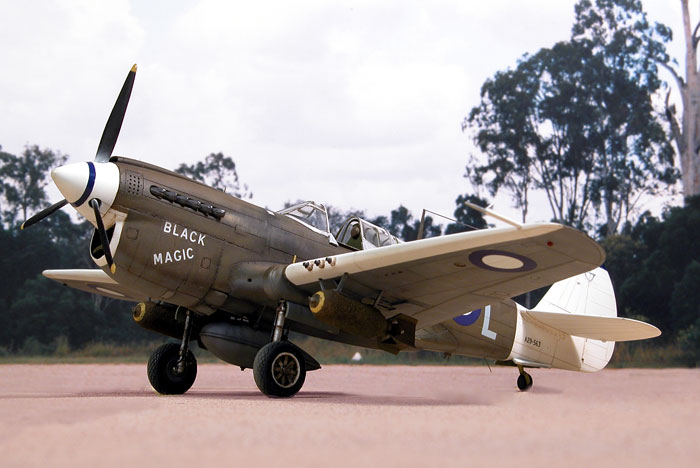
There is still a place in the world for Italeri's 1/48 scale P-40M/N!
Recommended.
Thanks to Italeri for the review sample.
Review Text and
Images Copyright © 2007 by Brett Green
Page Created 19 March, 2007
Last updated 24 December, 2007
Back to HyperScale Main Page
Back to Reviews Page
|
Home
| What's New |
Features |
Gallery |
Reviews |
Reference |
Forum |